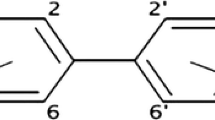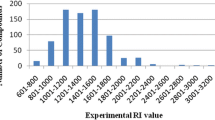Abstract
Quantitative structure–retention relationships (QSRR) models were constructed for the GC relative retention times (RRTs) of 126 polybrominated diphenyl ether (PBDE) congeners. First, a number of topological and connectivity indices descriptors were derived from E-dragon software. In a further step, six molecular descriptors were extracted by genetic algorithm (GA) coupled with multiple linear regression (MLR) method. The QSRR model was established using a support vector machine (SVM) algorithm as regression tool. High training sets correlation coefficients R 2 indicated that >99.6 % (except for stationary phase CP-Sil 19) of the total variation in the predicted RRTs is explained by the fitted models. It showed that we provided a more accurate model that was subsequently used to predict the RRTs of validation sets. The excellent statistical parameters Q 2 loo (correlation coefficient of leave-one-out cross validation) and validation sets correlation coefficients R 2 > 99.0 % reveal that the models are robust and have high internal and external predictive capability. According to sum of ranking differences (SRD) validation values, we concluded that DB-1 and DB-5 are the best two models.



Similar content being viewed by others
References
Renner R (2000) Environ Sci Technol 34:452–453
Hale RC, La Guardia MJ, Harvey E, Gaylor MO, Mainor TM (2006) Chemosphere 64:181–186
Hazrati S, Harrad S (2006) Environ Sci Technol 40:7584–7589
Lundstedt-Enkel K, Karlsson D, Darnerud PO (2010) J Chemometrics 24:710–718
Cunha S, Kalachova K, Pulkrabova J, Fernandes J, Oliveira M, Alves A, Hajslova J (2010) Chemosphere 78:1263–1271
Meerts IA, Van Zanden JJ, Luijks EA, van Leeuwen-Bol I, Marsh G, Jakobsson E, Bergman Å, Brouwer A (2000) Toxicol Sci 56:95–104
Vonderheide AP, Mueller KE, Meija J, Welsh GL (2008) Sci Total Environ 400:425–436
Wei H, Yang R, Li A, Christensen ER, Rockne KJ (2010) J Chromatogr A 1217:2964–2972
Vonderheide AP (2009) Microchem J 92:49–57
Wang Y, Li A, Liu H, Zhang Q, Ma W, Song W, Jiang G (2006) J Chromatogr A 1103:314–328
Zhang X, Ding L, Sun Z, Song L, Sun T (2009) Chromatographia 70:511–518
Zhang XT, Ren C, Guo JJ, Song LJ, Sun T (2012) Adv Mater Res 347:1769–1773
Fatemi MH, Ghorbanzad’e M, Baher E (2010) Anal Lett 43:823–835
Fatemi MH, Malekzadeh H (2012) J Sep Sci 35:2088–2094
Rayne S, Ikonomou MG (2003) J Chromatogr A 1016:235–248
Korytár P, Covaci A, de Boer J, Gelbin A, Brinkman UAT (2005) J Chromatogr A 1065:239–249
Yi Z, Li L, Zhang A, Wang L (2011) Chin J Chem 29:2495–2504
D’Archivio AA, Giannitto A, Maggi MA (2013) J Chromatogr A 1298:118–131
Zhang YH, Liu SS, Liu HY (2007) Chromatographia 65:319–324
Goodarzi M, Jensen R, Vander Heyden Y (2012) J Chromatogr B 910:84–94
Cai W, Xia B, Shao X, Guo Q, Maigret B, Pan Z (2001) J Mol Struct: THEOCHEM 535:115–119
Noorizadeh H, Farmany A (2010) Chromatographia 72:563–569
Whitley D (1994) Stat Comput 4:65–85
Jalali Heravi M, Kyani A (2007) Eur J Med Chem 42:649–659
Vapnik V (1998) Statistical learning theory. Wiley, New York
Luan F, Xue C, Zhang R, Zhao C, Liu M, Hu Z, Fan B (2005) Anal Chim Acta 537:101–110
Zhang J, Wang B, Zhang X, Huang DS, Zhang X, Reyes García C, Zhang L (2010) Advanced intelligent computing theories and applications. Springer, Berlin, pp 83–90
Cong Y, Li BK, Yang XG, Xue Y, Chen YZ, Zeng Y (2013) Chemom Intell Lab Syst
Vladimir VN, Vapnik V (1995) The nature of statistical learning theory. Springer, Heidelberg
Scholkopf B, Sung KK, Burges CJ, Girosi F, Niyogi P, Poggio T, Vapnik V (1997) Signal Proces, IEEE T 45:2758–2765
Smola AJ, Schölkopf B (2004) Stat Comput 14:199–222
Tetko IV, Gasteiger J, Todeschini R, Mauri A, Livingstone D, Ertl P, Palyulin VA, Radchenko EV, Zefirov NS, Makarenko AS (2005) J Comput Aid Mol Des 19:453–463
Riahi S, Pourbasheer E, Ganjali MR, Norouzi P (2009) J Hazard Mater 166:853–859
Pourbasheer E, Riahi S, Ganjali MR, Norouzi P (2009) Eur J Med Chem 44:5023–5028
Pourbasheer E, Riahi S, Ganjali MR, Norouzi P (2010) Eur J Med Chem 45:1087–1093
Randić M (2001) J Mol Graph Model 20:19–35
Moskovkina M, Bangov I, Patleeva AZ (2013) Bulg Chem Commun 45:9–23
Bangov I, Moskovkina M, Patleeva A (2010) Bulg Chem Commun 42:338–342
Dobrynin AA, Entringer R, Gutman I (2001) Acta Appl Math 66:211–249
Wang Y, Yao X, Zhang X, Zhang R, Liu M, Hu Z, Fan B (2002) Talanta 57:641–652
Frame GM (1997) Fresen J Anal Chem 357:714–722
Héberger K, Kollár-Hunek K (2011) J Chemometrics 25:151–158
Acknowledgments
The corresponding author is grateful for the financial support from the National Natural Science Foundation of China (21376114), and Department of Education of Liaoning Province, which made this work possible.
Author information
Authors and Affiliations
Corresponding authors
Rights and permissions
About this article
Cite this article
Zhang, X., Zhang, X., Li, Q. et al. Support Vector Machine Applied to Study on Quantitative Structure–Retention Relationships of Polybrominated Diphenyl Ether Congeners. Chromatographia 77, 1387–1398 (2014). https://doi.org/10.1007/s10337-014-2735-4
Received:
Accepted:
Published:
Issue Date:
DOI: https://doi.org/10.1007/s10337-014-2735-4




